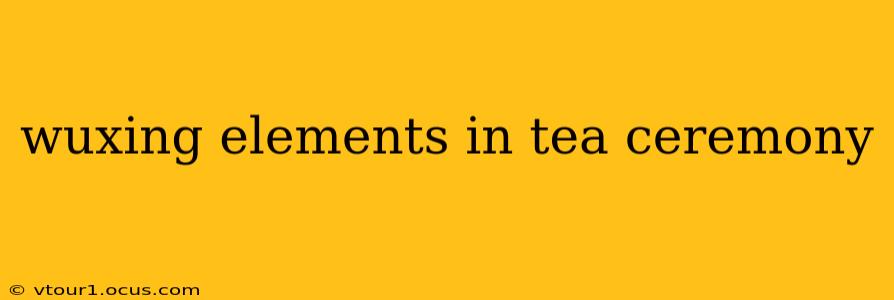The traditional Chinese tea ceremony, or Cha Dao, is far more than just the preparation and consumption of tea. It's a deeply symbolic ritual steeped in philosophy, aesthetics, and the intricate balance of the five elements, known as Wu Xing: Wood, Fire, Earth, Metal, and Water. Understanding how these elements intertwine within the ceremony enhances appreciation for its profound meaning and artistry. This exploration delves into the subtle yet significant presence of Wu Xing in every aspect of Cha Dao.
What are the Five Elements (Wu Xing)?
Before diving into their role in the tea ceremony, let's briefly revisit the fundamental principles of Wu Xing. These elements aren't merely physical substances but represent cyclical processes and interacting energies. Each element generates (sheng) and controls (ke) others in a continuous flow:
- Wood (木 – Mù): Represents growth, expansion, spring, and the liver/gallbladder meridians.
- Fire (火 – Huǒ): Symbolizes transformation, passion, summer, and the heart/small intestine meridians.
- Earth (土 – Tǔ): Represents stability, nurturing, late summer, and the stomach/spleen meridians.
- Metal (金 – Jīn): Symbolizes clarity, harvest, autumn, and the lung/large intestine meridians.
- Water (水 – Shuǐ): Represents introspection, stillness, winter, and the kidney/bladder meridians.
How are the Wu Xing Elements Reflected in the Tea Ceremony?
The interplay of Wu Xing is subtly woven throughout the entire tea ceremony, from the selection of teaware to the ritualistic movements involved.
1. The Teaware and its Elemental Associations
The materials used in the tea ceremony often reflect the elements:
- Wood: Wooden tea trays, scoop handles, and tea caddies represent the organic growth and nurturing aspect of Wood.
- Fire: Clay teapots, fired in kilns, embody the transformative power of Fire. The vibrant colors of some teaware also mirror this element.
- Earth: Earthenware teacups and teapots, made from clay, ground, and fired, represent the grounding and stable nature of Earth.
- Metal: Metal teapots, serving trays, or utensils represent the precision and refinement of Metal.
- Water: The water itself, essential to the brewing process, embodies the fluidity and adaptability of Water. The calming effect of the water also reflects the stillness of the element.
2. The Tea Itself and its Elemental Correspondences
Different types of tea can also be associated with specific elements based on their properties and effects:
- Wood: Green teas, known for their fresh, vibrant flavors, often correspond with Wood.
- Fire: Black teas, with their robust and intense flavors, are associated with Fire's transformative energy.
- Earth: Oolong teas, with their complex and balanced flavors, represent the Earth's nurturing and stable characteristics.
- Metal: White teas, with their delicate and refined flavors, embody the clarity and purity of Metal.
- Water: Herbal infusions, with their cooling and calming properties, can be linked to Water's introspective nature.
3. The Ritual Movements and their Elemental Significance
The graceful and deliberate movements in the tea ceremony also reflect the flow of Wu Xing:
- The smooth, flowing movements of preparing the tea might symbolize the fluidity of Water.
- The careful handling of fragile teaware reflects the delicate nature of Wood and Metal.
- The warmth and energy of the brewing process are akin to Fire.
- The stability and grounding of the tea table echoes Earth.
What are the benefits of understanding Wu Xing in the Tea Ceremony?
Understanding the Wu Xing elements enriches the experience of the tea ceremony by adding layers of meaning and appreciation. It allows one to perceive the subtle connections between seemingly disparate elements, fostering a deeper sense of harmony and balance. This deeper understanding helps connect the ritual to a broader philosophical context, making it a more profound and meaningful experience.
How does the Wu Xing philosophy contribute to the overall harmony of the tea ceremony?
The Wu Xing philosophy provides a framework for understanding the interconnectedness of all aspects of the tea ceremony, from the materials used to the ritualistic movements. By recognizing the interplay of these elements, participants can create a harmonious and balanced atmosphere that promotes mindfulness and tranquility. The cyclical nature of the five elements also symbolizes the constant change and flow of life, reminding us to appreciate the impermanence of all things.
What are some common misconceptions about Wu Xing and the tea ceremony?
One common misconception is that each element is rigidly assigned to a specific tea or teaware. In reality, the associations are often fluid and depend on personal interpretations and the specific context of the ceremony. Another misconception is that a strict adherence to elemental correspondence is essential for a successful ceremony. While understanding Wu Xing can enhance the experience, it shouldn't overshadow the overall goal of creating a peaceful and meaningful atmosphere.
By recognizing the subtle yet pervasive influence of the Wu Xing elements, we deepen our appreciation for the rich tapestry of meaning woven into the Chinese tea ceremony. It becomes a mindful practice, reflecting not just the preparation of a beverage but the harmonious balance of life itself.
